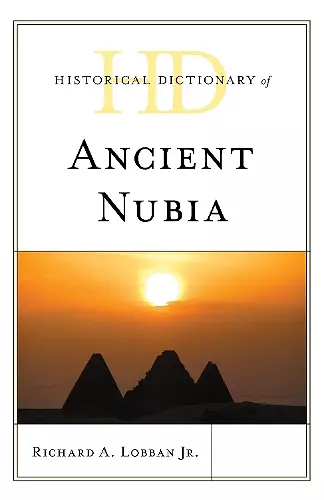Historical Dictionary of Ancient Nubia
Format:Hardback
Publisher:Rowman & Littlefield
Published:10th Mar '21
Currently unavailable, and unfortunately no date known when it will be back

This new book descends from a former combined reference book on Ancient and Medieval Nubia but now expands and focuses primarily on Prehistoric and Ancient times. It contextualizes the foundational roots of human evolution in the Paleolithic and Mesolithic stone ages and on to the Neolithic revolution built on farming and livestock. Meanwhile, Kerma was the most ancient African states and their relationship with dynastic Egypt. Precisely, ancient Kerma a was a serious political, economic and military rival to Old and Middle Kingdoms of Egypt. But in the New Kingdom the balance of regional forces was dramatically changed with Egyptians defeating Kerma and occupying and colonizing Kush/Nubia for 500 years. In the 11th century BCE the political unity of Egypt withered away and after recovering from foreign exploitation, Nubians began to reconstitute a small state at Kurru with renewed pyramid building and then finding no Egyptian resistance, these Nubians kings advanced on Egyptian Nubia and then on to Upper Egypt. Finally, Nubians were able to take over all of Egypt as the pharaohs of century-long Dynasty XXV. This so-called ‘Ethiopian” dynasty had the famed pharaohs of Piankhy, Shabaka, Shabataka, Taharka and Tanutamun ruling for various terms, three of who are mentioned in the Biblical Old Testament.
Even when Nubians were expelled from Egypt by foreign Assyrian invaders, they retreated to Napata to carry on their ancient state for three more independent centuries as Egyptian remained conquered by various foreigners for 2,500 years. Most notable of these foreign conquers of Egypt were the Greeks (Ptolemies) and the Roman (who arrived and polytheists and left as Christians. During this Greco-Roman period in Egypt, Nubians strategically withdrew still further south to the Kingdom of Meroë (from the 4th century BCEE to the 4th century CE. Meroe is also covered in great detail as it was famed for many regnant queens, a unique and undeciphered writing system, iron-production and important monumental works including more pyramids than found in Egypt, Yes, smaller and later but many more pyramids that are still standing in several World Heritage sites in Nubia. After Meroë began a long decline it was finally vulnerable to attack from Christian Axum on the 4th century CE. Two murky centuries of regional rule, known as the X-Group were to...
This new reference book is focused on Medieval Christian Nubia and its historical and religious context. This descends from the former Historical Dictionary of Ancient and Medieval Nubia (2004) that had combined both subjects, but new excavations and research have demanded a still deeper look at the often-neglected Christian civilizations on the Sudanese Nile. This is an extremely ample, comprehensive and deeper book by Lobban that neatly outlines and contextualizes the emergence and development of Christianity in Nubia. This region beyond the first cataract on the Nile contributed fundamentally to the development, continuity and distinctiveness of Mediterranean and African civilization evolving from the pre-Christian Greco-Roman period and evolved in the complex schisms within Christianity. This epoch was terminated by the rise of Islam in Sudan after almost 1,000 years, but actually lasted longer than the present period of Islam.
-- EUGENIO FANTUSATI, professor, International Association of the Study of the Mediterranean and the Orient (ISMEO),ISBN: 9781538133385
Dimensions: 228mm x 161mm x 44mm
Weight: 966g
538 pages